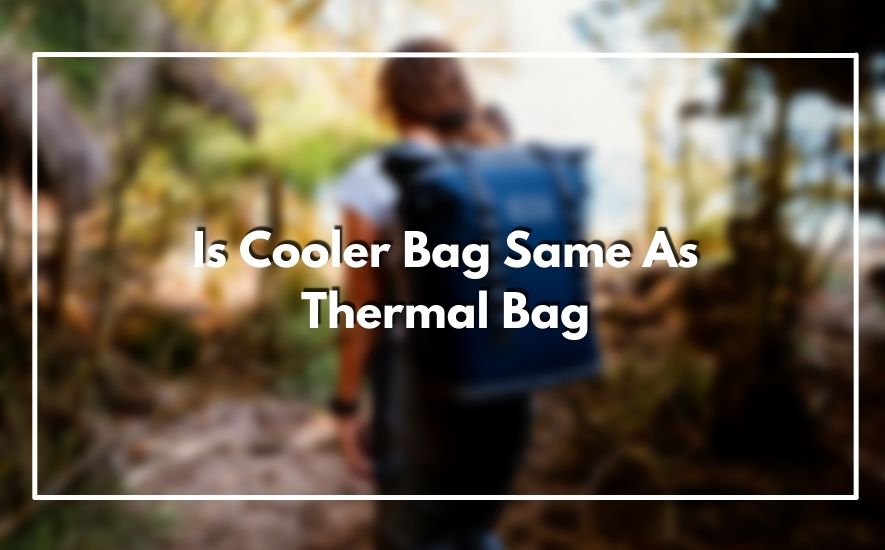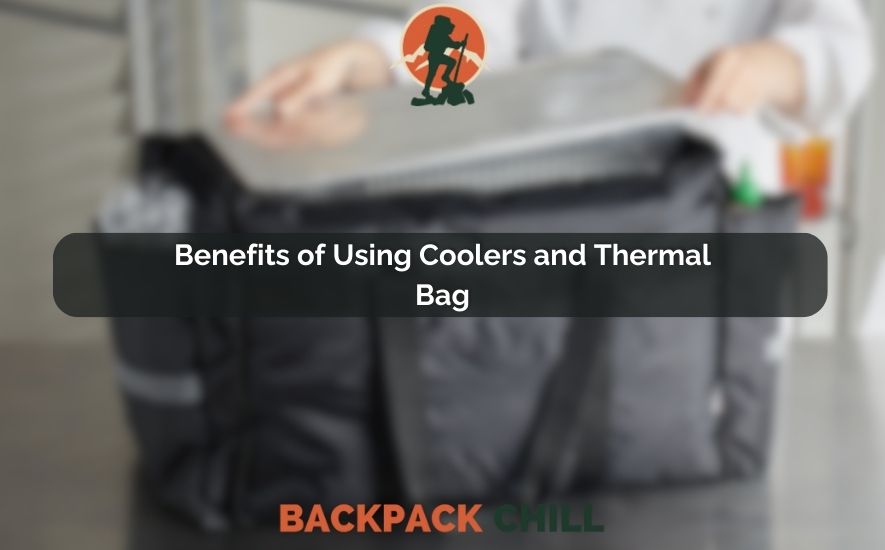Physical Address
304 North Cardinal St.
Dorchester Center, MA 02124
Physical Address
304 North Cardinal St.
Dorchester Center, MA 02124

When it comes to preserving the freshness and temperature of our food and beverages while on the go, both cooler bags and thermal bags come to the rescue. But are they really the same? It’s a common query that often leaves consumers scratching their heads. In this insightful exploration, we aim to unravel the mystery surrounding these two indispensable travel companions.
Is Cooler Bag same as Thermal Bag? Cooler bags and thermal bags may seem similar, but they serve different purposes. Cooler bags keep items cold with ice packs, while thermal bags retain heat for hot meals. Their distinct functions make them essential companions for various activities.
Cooler bags and thermal bags share a common objective of maintaining desired temperatures, yet they possess subtle nuances that set them apart. Delving into their distinctive features and functionalities, we seek to enlighten readers on how each serves as a versatile ally in different scenarios.
So, whether you’re planning a picnic in the park or a long road trip, join us as we unravel the fascinating differences between cooler bags and thermal bags.
The first noticeable difference lies in their design and construction. Coolers, often made of rigid materials like hard plastic or metal, feature sturdy exteriors with insulated walls. The insulation effectively traps cold air inside, preventing heat transfer from the outside.
On the other hand, thermal bags are generally softer and more flexible. They employ advanced insulation materials, such as foam or high-tech fabrics, which offer excellent temperature retention without compromising on portability.
Portability is a significant factor when deciding between a cooler and a thermal bag. Coolers, due to their rigid structure and heavier materials, tend to be bulkier and less convenient to carry around, especially for extended distances.
Thermal bags, on the contrary, are lightweight and often come with adjustable shoulder straps or handles, making them effortless to carry, ideal for picnics, hikes, or trips to the beach.
Storage capacity is another crucial aspect where coolers and thermal bags differ. Coolers, with their rigid walls and spacious interiors, can generally hold more items, making them perfect for larger gatherings or extended outdoor adventures.
On the other hand, thermal bags, though more compact, are still remarkably efficient in their storage capabilities, suitable for day trips or carrying a moderate amount of food and drinks.
One of the most vital factors to consider is how long each can keep your items at the desired temperature. Coolers, with their thick insulation and sturdy construction, can retain cold temperatures for an extended period, often lasting several days. This feature makes them an excellent choice for camping trips or long journeys.
However, thermal bags, while not matching the extended retention of coolers, can still maintain temperatures for a significant amount of time, typically lasting up to a day. They are ideal for shorter outings or when frequent temperature changes are anticipated.
Cost plays a crucial role in decision-making for many consumers. Coolers, with their more robust construction and long-lasting insulation, are generally more expensive than thermal bags.
While investing in a high-quality cooler can be a great option for frequent outdoor enthusiasts, thermal bags provide an affordable alternative without compromising on performance.
Another aspect to consider is the versatility offered by each option. Coolers, due to their larger capacity and robust build, can serve multiple purposes, including storing perishable goods, acting as a temporary seat, or even as a fishing tackle box.
Thermal bags, although less versatile, are still handy in various situations, such as carrying groceries, packing lunch for work, or keeping medicines at the right temperature during travel.

Both coolers and thermal bags are designed with specific materials that enhance their insulating properties. The main component is often foam, typically made from expanded polystyrene (EPS) or polyurethane.
This foam has a low thermal conductivity, which means it doesn’t conduct heat effectively. By minimizing heat transfer through the walls of the cooler or bag, it helps maintain the internal temperature.
Many coolers and thermal bags feature reflective layers in their construction. These layers are usually made from materials like Mylar, aluminum, or other metallic coatings. Their purpose is to prevent radiant heat from entering the container. When the sun’s rays hit the reflective surface, they are bounced back, reducing the amount of heat absorbed by the cooler or thermal bag.
A critical factor in the cooling efficiency of coolers and thermal bags is their ability to retain cold air inside and keep warm air out.
Quality products are designed with tight-fitting lids or zippers that create an airtight seal. This prevents warm air from infiltrating the interior and maintains the cold temperature for an extended period.
Ice packs or ice cubes play a crucial role in cooling the contents of coolers and thermal bags. When placed inside, they absorb heat from the surrounding environment, causing the ice to melt. The process of melting requires energy, and this energy is taken from the contents of the container, effectively cooling them down. The resulting cold water created from the melted ice continues to keep the interior cool.
Coolers and thermal bags rely on the principles of conduction and convection to maintain their cooling effect.
Conduction is the transfer of heat through direct contact between two materials, while convection involves the movement of fluids (in this case, air and melted ice) that carry heat away from the container’s interior. The insulation and airtight design of the cooler or bag minimize the heat transfer through conduction, while the flow of air and water aids in the convection process.

One of the primary benefits of coolers and thermal bags is their ability to preserve the freshness of perishable items.
Whether you’re carrying a homemade meal, chilled beverages, or delicate fruits, these insulated bags create a controlled environment that slows down the temperature change, ensuring your food remains at an ideal temperature for an extended period. This feature is particularly crucial during warm weather or when traveling long distances.
In the age of environmental consciousness, coolers and thermal bags present themselves as a more eco-friendly alternative to single-use plastic bags or disposable containers. By opting for reusable, insulated bags, you can significantly reduce plastic waste and contribute to the preservation of our planet. This conscious choice aligns with sustainable living practices and promotes a greener lifestyle.
While initial investments in quality coolers and thermal bags might seem higher, they prove to be cost-effective in the long run.
By utilizing these reusable containers, you can save money spent on disposable items, such as paper bags, plastic wraps, and ice packs. Moreover, their durability ensures they withstand regular use, providing value for your money over an extended period.
Using coolers and thermal bags not only maintains the freshness of your food but also ensures its safety. By preventing bacterial growth and food spoilage, these insulated carriers reduce the risk of foodborne illnesses, ensuring you and your loved ones enjoy safe and healthy meals. This advantage is particularly important when carrying perishable items during outdoor activities or extended travel.
The primary purpose of coolers and thermal bags is to regulate temperature effectively. However, they are not just limited to cooling items. In colder weather or situations where maintaining warmth is crucial, such as transporting hot meals or keeping winter supplies, these insulated carriers prove equally efficient in preserving heat and preventing temperature loss.
In conclusion, while the terms “cooler bag” and “thermal bag” are often used interchangeably, it is important to note that they do possess some subtle differences.
While both bags serve the purpose of keeping items cool or warm, a cooler bag typically focuses more on maintaining a lower temperature for food and beverages, with the aid of insulating materials and ice packs. On the other hand, a thermal bag places emphasis on preserving heat, making it suitable for keeping meals warm during transportation.
It is essential to consider these nuances when choosing the right bag for your specific needs, whether you require insulation for cooling or heating purposes. Ultimately, understanding the intended usage will guide you towards selecting the most suitable bag to meet your requirements.
Absolutely! A cooler is indeed better than an insulated bag in certain situations. While both have their merits, a cooler offers superior temperature retention, making it ideal for keeping items chilled or even frozen for extended periods. The insulation in a cooler is usually thicker and more effective at maintaining a consistent temperature, ensuring your drinks and perishables stay refreshingly cool.
Additionally, coolers often come with features like ice packs or gel packs that enhance their cooling capabilities further. So, when you’re planning a picnic, camping trip, or a day at the beach, a cooler would be your go-to companion for preserving the freshness of your food and drinks.
A cooler bag, also known as an insulated bag, is a versatile and handy container designed to maintain the temperature of its contents. It’s typically made of durable and insulating materials that help regulate the internal temperature, keeping items either cool or warm as needed.
The bag’s insulation acts as a barrier, preventing external heat from entering or internal heat from escaping, ensuring your food, drinks, or even medication stay at the desired temperature for a more extended period.
Yes, cooler bags are designed to keep heat out just as effectively as they keep it in. The insulation used in cooler bags acts as a thermal barrier, preventing external heat from entering the bag and affecting the temperature of its contents. This ability to keep heat out is particularly useful when you’re carrying chilled or frozen items on a hot day or during a sunny outdoor excursion.
By effectively blocking external heat, the cooler bag ensures that your food, beverages, or any other temperature-sensitive items remain cool and fresh. This feature makes cooler bags indispensable for various scenarios, such as picnics, beach trips, grocery shopping, or transporting perishable goods.
Its primary use is to preserve temperature-sensitive items, such as perishable foods, fruits, vegetables, meats, and beverages.
Cooler bags are popular for picnics, outdoor activities, and travel, as they keep food fresh and drinks refreshing. They are also useful for transporting chilled or frozen items from the grocery store to home. In contrast, some specialized cooler bags are designed to keep food warm, making them ideal for carrying hot meals or soups during outings or lunch breaks.